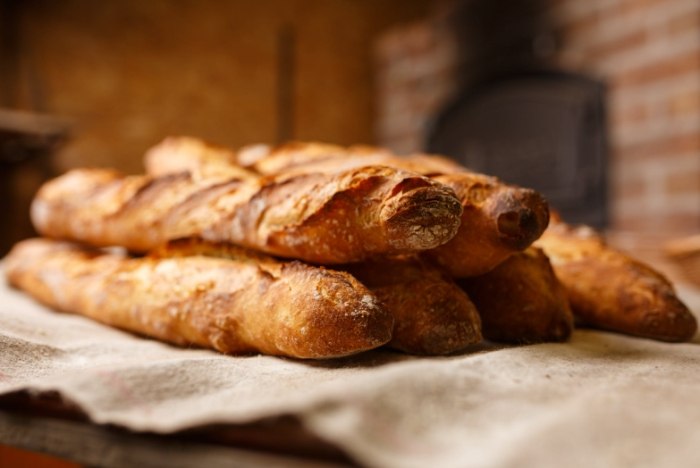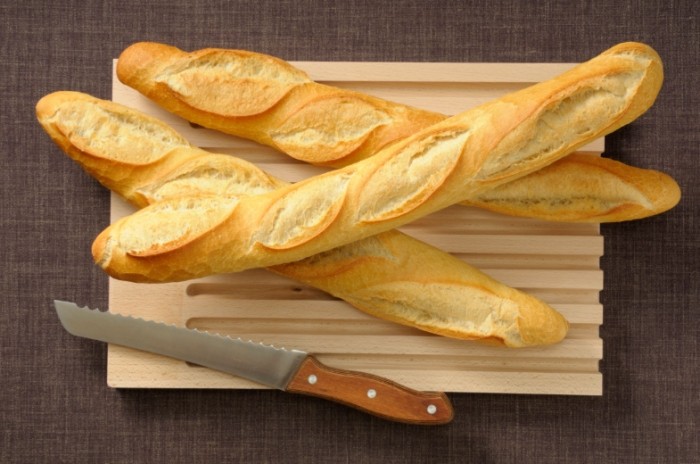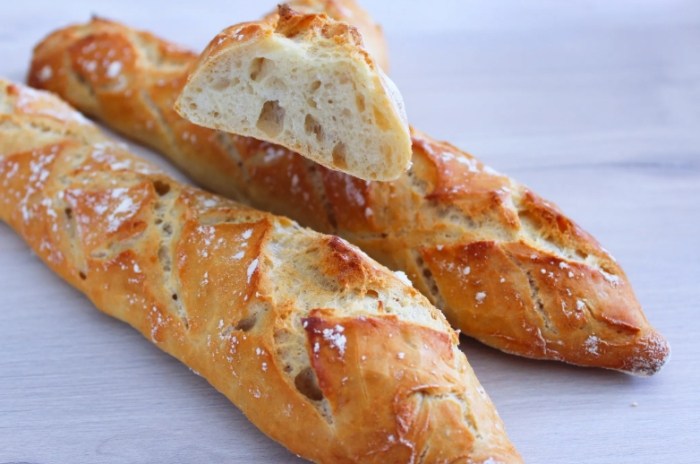La Baguette: Authentic French Recipe & Baking Secrets
Advertisements
Ever wondered what makes the perfect La Baguette? Discover the art of France's iconic bread – from crispy crust secrets to authentic Parisian baking techniques. Learn where to find the best baguettes in France, how to spot quality flour marks, and proper storage tips. Whether you're a home baker or food traveler, master the craft of making and enjoying this golden, airy French staple like a true local!
Table of Contents
In the heart of French culinary culture lies a simple yet iconic bread that has become synonymous with France itself—la baguette. As a proud local of Paris, I’ve grown up with the aroma of freshly baked baguettes wafting through the streets every morning. This humble loaf, with its golden crust and soft, airy interior, is more than just food; it’s a symbol of our national identity, a daily ritual, and a testament to centuries of baking tradition. In this comprehensive guide, I’ll take you through the rich history, intricate craftsmanship, versatile uses, and cultural significance of la baguette, all from the perspective of someone who lives and breathes French cuisine.
Historical Origins of La Baguette

A Bread Through the Ages
The story of la baguette begins long before it took on its familiar form. Bread has been a staple in France since ancient times, with evidence of wheat cultivation and baking dating back to the Neolithic period. However, the baguette as we know it today is a relatively recent development in the long history of French bread-making.
- Early Forms: In the Middle Ages, bread was often baked in large, round loaves, sometimes weighing several pounds. These loaves were shared among families and were a central part of the daily diet. The shape and size of bread varied greatly depending on regional traditions and available ingredients.
- The Industrial Revolution: The 19th century saw significant changes in bread production. The introduction of steam-powered mills and railways made it easier to transport flour, leading to more consistent bread quality across the country. Additionally, the growth of urban populations created a demand for smaller, more portable loaves.
- The Birth of the Baguette: The exact origin of the baguette is somewhat disputed, but it is widely believed to have emerged in the late 19th or early 20th century. One popular theory suggests that the baguette was created in response to a 1920 law that prohibited bakers from starting work before 4 a.m. To ensure that fresh bread was available for breakfast, bakers needed a loaf that could be baked quickly. The long, thin shape of the baguette allowed for faster baking times, making it the perfect solution.
Cultural Significance
La baguette has become deeply ingrained in French culture, symbolizing the nation’s love for simplicity, tradition, and quality. It is a common sight in French households, cafes, and restaurants, and is often enjoyed as part of a classic French breakfast or as an accompaniment to meals.
- Everyday Life: For many French people, a visit to the local bakery to pick up a fresh baguette is a daily ritual. The sound of the baguette being wrapped in paper and the aroma of freshly baked bread are cherished aspects of daily life.
- Cultural Icon: The baguette has also become a cultural icon, representing France on the global stage. It is often featured in films, literature, and art, and is recognized worldwide as a symbol of French cuisine.
Core Craftsmanship of La Baguette

The Ingredients
At its core, la baguette is a simple bread made from just a few basic ingredients: flour, water, yeast, and salt. However, the quality of these ingredients and the skill of the baker play a crucial role in determining the final product.
- Flour: High-quality French flour, typically T55 or T65, is used to make baguettes. These flours have a moderate protein content, which gives the bread its characteristic texture and flavor.
- Water: The water used in baguette dough should be of good quality, as it affects the fermentation process and the overall taste of the bread.
- Yeast: Fresh yeast or sourdough starter is used to leaven the dough. Sourdough starter, in particular, adds a unique flavor and complexity to the bread.
- Salt: Salt is added to enhance the flavor of the bread and to control the fermentation process.
The Baking Process
The process of making a baguette is a delicate art that requires patience, skill, and attention to detail. From mixing the dough to shaping and baking, each step is crucial in creating the perfect loaf.
Mixing and Fermentation
- Autolyse: The first step in making baguette dough is the autolyse, where the flour and water are mixed together and left to rest for about 30 minutes. This allows the flour to fully hydrate and helps to develop the gluten network.
- Adding Yeast and Salt: After the autolyse, yeast and salt are added to the dough. The dough is then mixed until it forms a smooth, elastic consistency.
- Fermentation: The dough is left to ferment in a warm place for several hours. During this time, the yeast feeds on the sugars in the flour, producing carbon dioxide gas that causes the dough to rise.
Shaping and Proofing
- Dividing and Pre-shaping: The fermented dough is divided into individual pieces, which are then pre-shaped into rough logs. This helps to develop the gluten structure and prepares the dough for the final shaping.
- Final Shaping: The pre-shaped dough is then rolled out into long, thin loaves, known as baguettes. The shaping process requires a gentle touch to avoid deflating the dough and to create the characteristic slashes on the surface of the bread.
- Proofing: The shaped baguettes are left to proof for another 30 minutes to an hour, allowing them to rise slightly before baking.
Baking
- Preheating the Oven: The oven is preheated to a high temperature, typically around 230-250°C (446-482°F). A baking stone or steaming tray is often used to create a steamy environment, which helps to form a crisp crust.
- Baking: The baguettes are placed in the oven and baked for about 20-25 minutes. The high temperature causes the crust to brown quickly, while the steam helps to keep the interior soft and airy.
- Cooling: After baking, the baguettes are removed from the oven and left to cool on a wire rack. This allows the crust to crisp up further and the interior to set.
Homemade Baguette Recipe

For those who want to try their hand at making baguettes at home, here’s a simple recipe that captures the essence of this classic French bread.
Ingredients
- 500g T55 or T65 French flour
- 325ml warm water
- 10g fresh yeast or 5g instant yeast
- 10g salt
Instructions
- Autolyse: In a large bowl, combine the flour and water. Mix until just combined, then cover and let rest for 30 minutes.
- Adding Yeast and Salt: After the autolyse, add the yeast and salt to the dough. Mix until the dough forms a smooth, elastic consistency. This can be done by hand or with a stand mixer fitted with a dough hook.
- Fermentation: Cover the bowl with a damp cloth and let the dough ferment in a warm place for 2-3 hours, or until it has doubled in size.
- Dividing and Pre-shaping: Turn the dough out onto a lightly floured surface. Divide it into 3 equal pieces. Pre-shape each piece into a rough log by gently rolling it on the counter.
- Final Shaping: Take one piece of dough and roll it out into a long, thin loaf, about 30-40cm (12-16 inches) in length. Repeat with the remaining pieces. Place the shaped baguettes on a baking sheet lined with parchment paper.
- Proofing: Cover the baguettes with a damp cloth and let them proof for 30-60 minutes, or until they have risen slightly.
- Baking: Preheat the oven to 230°C (446°F). Place a baking stone or steaming tray in the oven to preheat. Using a sharp knife or razor blade, make 3-4 diagonal slashes on the surface of each baguette. Place the baking sheet with the baguettes in the oven and pour a cup of water onto the steaming tray to create steam. Bake for 20-25 minutes, or until the crust is golden brown and the bread sounds hollow when tapped on the bottom.
- Cooling: Remove the baguettes from the oven and let them cool on a wire rack before serving.
Pairing Recommendations for La Baguette

La baguette is incredibly versatile and can be enjoyed in a variety of ways. Whether you’re looking for a simple snack or a more elaborate meal, here are some pairing recommendations to enhance your baguette experience.
Breakfast
- Butter and Jam: A classic French breakfast, spreading a generous amount of salted butter and your favorite jam on a freshly baked baguette is a simple yet delicious way to start the day.
- Ham and Cheese: For a more substantial breakfast, try making a sandwich with thinly sliced ham, Emmental cheese, and a little Dijon mustard.
Lunch and Dinner
- Charcuterie Board: A baguette is the perfect accompaniment to a charcuterie board filled with cured meats, cheeses, olives, and pickles. The bread can be used to scoop up the delicious morsels or to make mini sandwiches.
- Salad: Crumble a baguette into croutons and add them to your favorite salad for a crunchy texture. They pair particularly well with Caesar salad or a classic Niçoise salad.
- Soup: Dipping a baguette into a warm bowl of soup is a comforting and satisfying meal. Try it with a classic French onion soup or a hearty vegetable stew.
Snacks and Appetizers
- Bruschetta: Toast slices of baguette and top them with fresh tomatoes, basil, garlic, and olive oil for a simple and delicious appetizer.
- Cheese and Wine: A baguette is a must-have when enjoying a selection of French cheeses and a glass of wine. The bread helps to cleanse the palate between bites and enhances the flavors of the cheese.
Regional Specialties of La Baguette
While the classic baguette is beloved throughout France, different regions have their own unique variations and specialties. Here are a few examples of regional baguette styles that you might encounter on your travels.
Parisian Baguette
- Characteristics: The Parisian baguette is the most well-known and widely recognized style. It has a thin, crisp crust and a soft, airy interior. The dough is typically made with a combination of white flour and a small amount of whole wheat flour, giving it a slightly nutty flavor.
- Where to Find It: You can find classic Parisian baguettes at almost any bakery in Paris. Some of the most famous bakeries include Poilâne, Du Pain et des Idées, and Gontran Cherrier.
Provencal Fougasse
- Characteristics: Fougasse is a type of flatbread that originated in the Provence region of France. It is similar in shape to a baguette but is often cut with slashes to create a lacy pattern. Fougasse can be made with a variety of ingredients, such as olives, herbs, or cheese, and has a slightly denser texture than a traditional baguette.
- Where to Find It: Fougasse is a popular specialty in Provence and can be found at many local bakeries and markets. Look for bakeries in cities like Aix-en-Provence, Marseille, and Nice.
Breton Kouign-Amann Bread
- Characteristics: While not strictly a baguette, the Breton kouign-amann bread is a delicious regional specialty from Brittany. It is made with a laminated dough similar to that used for croissants, but with the addition of sugar. The result is a sweet, buttery bread with a crisp, caramelized crust.
- Where to Find It: Kouign-amann bread can be found at bakeries in Brittany, particularly in cities like Rennes, Brest, and Saint-Malo.
Top Baguette Bakeries in France
France is home to countless bakeries that specialize in making exceptional baguettes. Here’s a list of some of the top bakeries in the country, known for their high-quality bread and traditional baking techniques.
Paris
| Bakery Name | Location | Specialties |
|---|---|---|
| Poilâne | 8 Rue du Cherche-Midi, 75006 Paris | Sourdough baguettes, pain de campagne |
| Du Pain et des Idées | 34 Rue Yves Toudic, 75010 Paris | Escargot (snail-shaped) baguette, pistachio and cherry bread |
| Gontran Cherrier | 22 Rue Caulaincourt, 75018 Paris | Creative baguette flavors, such as matcha and sesame |
Lyon
| Bakery Name | Location | Specialties |
|---|---|---|
| Boulangerie Pâtisserie Brun | 24 Rue de la République, 69002 Lyon | Classic baguettes, Lyon-style brioche |
| Boulangerie du Palais | 8 Rue du Palais, 69005 Lyon | Traditional French breads, pastries |
Bordeaux
| Bakery Name | Location | Specialties |
|---|---|---|
| Boulangerie Patisserie Mallet | 14 Rue Sainte-Catherine, 33000 Bordeaux | Baguettes, canelés (small caramelized cakes) |
| Boulangerie Pâtisserie du Marché des Capucins | Place des Capucins, 33000 Bordeaux | Freshly baked breads, pastries from the local market |
Q&A
1. Is it la or le baguette?
In French, the word “baguette” is feminine, so it is preceded by the definite article “la.” Therefore, it is “la baguette.” This is an important distinction to make, as using the wrong article can change the meaning of the sentence or make it sound incorrect.
2. What is la baguette in French?
La baguette is a long, thin loaf of bread that is a staple in French cuisine. It is characterized by its crisp crust, soft interior, and characteristic slashes on the surface. The word “baguette” comes from the French word for “wand” or “baton,” which refers to its elongated shape.
3. Where is the best baguette in France?
Determining the “best” baguette in France is a subjective matter, as there are countless bakeries across the country that produce exceptional bread. However, some bakeries are particularly renowned for their baguettes, such as Poilâne in Paris, which has been making sourdough baguettes since 1932. Other notable bakeries include Du Pain et des Idées and Gontran Cherrier in Paris, as well as local bakeries in regions like Provence and Brittany.
4. Why are baguettes so famous in Paris?
Baguettes are famous in Paris for several reasons. Firstly, they are a staple of French cuisine and are deeply ingrained in the city’s culture and daily life. Secondly, Paris is home to some of the most famous and respected bakeries in the world, which have perfected the art of baguette-making over centuries. Finally, the baguette’s simple yet delicious flavor, combined with its versatility, makes it a popular choice for both locals and tourists alike.
In conclusion, la baguette is more than just a loaf of bread; it’s a symbol of French culture, tradition, and culinary excellence. Whether you’re enjoying a freshly baked baguette from a local bakery in Paris or trying your hand at making one at home, this iconic bread is sure to delight your taste buds and transport you to the heart of France.
Advertisements